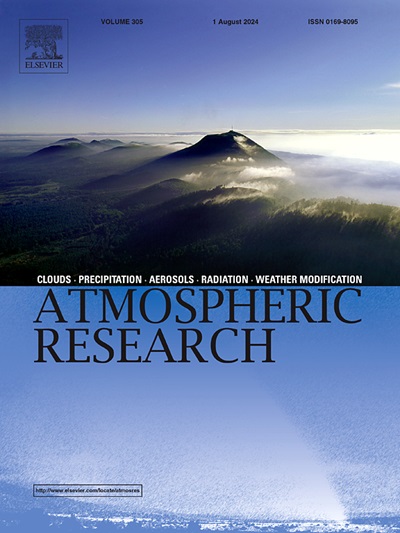地形分辨率对青藏高原南部一次极端暴雪过程的影响:空间分布和云微物理过程
IF 4.5
2区 地球科学
Q1 METEOROLOGY & ATMOSPHERIC SCIENCES
引用次数: 0
摘要
降水是青藏高原寒冷季节水循环的重要组成部分。研究模拟中不同地形分辨率对TP降水分布和雨雪相变的影响,有助于了解模拟误差的来源,并有助于评估和改进。本研究利用3种地形分辨率WRF30s、WRF2m和WRF5m对2008年10月孟加拉湾风暴影响下青藏高原大尺度极端降水过程进行了模拟实验,该过程位于喜马拉雅山和雅鲁藏布江大峡谷附近,是受北上水汽影响的代表性区域。结果表明,地形分辨率影响降水量和相位分布。在喜马拉雅山北部,在3 km以上观测到以降雪为主的以“湿偏”为基础的“相位偏”,随着地形分辨率的降低而增强,这与地形平滑导致的水汽通量输送增强和冷偏增大有关。位于峡谷的波米站受到风暴的影响,正在经历由雪到雨的过渡阶段,因此受到进一步的关注。研究不仅揭示了暴雨影响下降水对TP的云微物理特征,还进一步揭示了融雪相变的减弱,表现为降雪量的增加伴随着地形分辨率的降低。对波米地区云微物理过程的进一步详细分析表明,波米地区云微物理过程与峡谷附近地形增加、地形分辨率降低时融化层压缩导致雪霰融化速率降低有关。因此,在模拟过程中,地形分辨率引起的TP上降水的分布和相变是值得注意的。本文章由计算机程序翻译,如有差异,请以英文原文为准。
Impacts of terrain resolution on an extreme snowstorm process over the Southern Tibetan Plateau: Spatial distribution and cloud microphysical processes
Precipitation is an essential component of the water cycle over the Tibetan Plateau (TP) in cold seasons. Investigating the impacts of various terrain resolutions in simulations on the precipitation distribution and rain-snow phase transition on the TP helps to understand the sources of simulation error and contributes to assessment and improvement. In this study, three types of terrain resolutions were used to conduct simulation experiments (namely WRF30s, WRF2m and WRF5m) on a large-scale extreme precipitation process over the TP under the influence of a storm over the Bay of Bengal in October 2008 near the Himalayas and the Yarlung Zangbo Grand Canyon, which serve as representative regions influenced by northward moisture. The results indicate that the terrain resolutions affect the precipitation amount and phase distribution. On the north of the Himalayas, a snowfall-dominated “phase bias” based on “wet bias” is observed above 3 km, which strengthens as the terrain resolution reduces, relating to the stronger water vapor flux transport and larger cold bias resulting from the terrain smoothing. The Bomi station, which is located in the canyon, undergoing a snow-to-rain phase transition influenced by the storm received further attention. The study not only shows the cloud microphysical characteristics of the precipitation on the TP under the influence of storms, but further reveals the snow melting phase transition weakening, manifested as the increase of snowfall accompanied by the decrease of terrain resolution. Further detailed analysis of cloud microphysical process in Bomi shows that the latter is related to the decrease melting rates of snow and graupel caused by the compression of the melting layer when the terrain near canyon increases with terrain resolution decrease. Consequently, the distribution and phase transition of precipitation on the TP induced by terrain resolutions requires attention during the simulation.
求助全文
通过发布文献求助,成功后即可免费获取论文全文。
去求助
来源期刊

Atmospheric Research
地学-气象与大气科学
CiteScore
9.40
自引率
10.90%
发文量
460
审稿时长
47 days
期刊介绍:
The journal publishes scientific papers (research papers, review articles, letters and notes) dealing with the part of the atmosphere where meteorological events occur. Attention is given to all processes extending from the earth surface to the tropopause, but special emphasis continues to be devoted to the physics of clouds, mesoscale meteorology and air pollution, i.e. atmospheric aerosols; microphysical processes; cloud dynamics and thermodynamics; numerical simulation, climatology, climate change and weather modification.
 求助内容:
求助内容: 应助结果提醒方式:
应助结果提醒方式:


